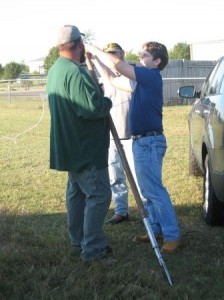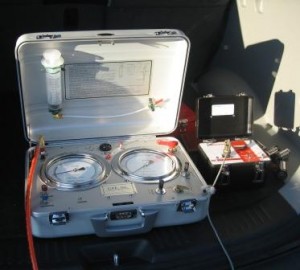
Attaching Drill Rod to the Dilatometer
Adam Bench with GP&E out of Gainsville, Florida, delivered the new dilatometer equipment to our project site in Walters, Oklahoma on October 5, 2010. Adam stuck around to introduce us to the equipment setup, measurement procedures and analysis software. After a rough start (who knew moisture could get into a nitrogen tank?!), the project went relatively smoothly. After a hard day at work, Adam was treated to an outing in Lawton, Oklahoma with DSO and RRC.

Brad Bettes (DSO), Todd SImpson (DSO), Kristi Bumpas (RRC) and Adam Bench (GP&E)
The Marchetti flat dilatometer test (DMT) providesa a rational, inexpensive method to determine the engineering parameters for the design of earthworks and structural foundations. The test is performed insitu by pushing into the soil a blade-shaped probe that has an expandable membrane on one side. Stopping at depth intervals as close as 6 inches, the operator performs the DMT by expanding this membrane. From the data the engineer can obtain a stratigraphic profile of commonly used soil engineering properties for analysis. These include soil type, shear strength, deformation modulus, preconsolidation stress, insitu horizontal stress, insitu porewater pressure and the rate of consolidation in soils ranging from coarse sands to clays. (Federal Highway Administration “Guidelines for Using the CPT, CPTU and Marchetti DMT for Geotechnical Design”, FHWA-PA-87-024+84-24 Volume III, US Department of Transportation, Washington, DC, 1988)

Dilatometer Gauges
